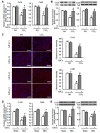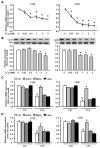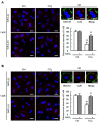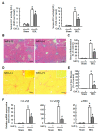Gadolinium Chloride Restores the Function of the Gap Junctional Intercellular Communication between Hepatocytes in a Liver Injury
- PMID: 31370360
- PMCID: PMC6695937
- DOI: 10.3390/ijms20153748
Gadolinium Chloride Restores the Function of the Gap Junctional Intercellular Communication between Hepatocytes in a Liver Injury
Abstract
Background: Gadolinium chloride (GdCl3) has been reported to attenuate liver injury caused by a variety of toxicants. Gap junctional intercellular communication (GJIC) is thought to be essential in controlling liver homeostasis and pathology. Here we evaluate the effects of GdCl3 on functional GJIC and connexin expression in mouse models and primary hepatocytes.
Methods: Mice were administered GdCl3 intraperitoneally the day before a carbon tetrachloride (CCl4) injection or bile duct ligation (BDL) operation. Primary hepatocytes were treated with CCl4 or lipopolysaccharides (LPS), with or without GdCl3. A scrape loading/dye transfer assay was performed to assess the GJIC function. The expression of connexins was examined by real-time reverse transcription polymerase chain reaction (RT-PCR), western blot and immunofluorescent staining.
Results: CCl4 treatment or the BDL operation led to the dysfunction of GJIC and a down-regulation of Cx32 and Cx26 in injured liver. GdCl3 administration restored GJIC function between hepatocytes by facilitating the transfer of fluorescent dye from one cell into adjacent cells via GJIC, and markedly prevented the decrease of Cx32 and Cx26 in injured liver. In primary hepatocytes, CCl4 or LPS treatment induced an obvious decline of Cx32 and Cx26, whereas GdCl3 pretreatment prevented the down-regulation of connexins. In vivo GdCl3 protected hepatocytes and attenuated the liver inflammation and fibrosis in liver injury mouse models.
Conclusion: GdCl3 administration protects functional GJIC between hepatocytes, and prevents the decrease of connexin proteins at mRNA and protein levels during liver injury, leading to the alleviation of chronic liver injury.
Keywords: connexin; gadolinium chloride; gap junctional intercellular communication; hepatocyte; liver injury.
Conflict of interest statement
The authors declare no conflict of interest.
Figures







Similar articles
-
Interruption of hepatic gap junctional communication in the rat during inflammation induced by bacterial lipopolysaccharide.Shock. 2000 Jul;14(1):53-9. doi: 10.1097/00024382-200014010-00010. Shock. 2000. PMID: 10909894
-
Taurine preserves gap junctional intercellular communication in rat hepatocytes under oxidative stress.J Gastroenterol. 2000;35(5):361-8. doi: 10.1007/s005350050361. J Gastroenterol. 2000. PMID: 10832671
-
Trichostatin a enhances gap junctional intercellular communication in primary cultures of adult rat hepatocytes.Toxicol Sci. 2006 Jun;91(2):484-92. doi: 10.1093/toxsci/kfj152. Epub 2006 Mar 10. Toxicol Sci. 2006. PMID: 16531468
-
Role of connexin (gap junction) genes in cell growth control and carcinogenesis.C R Acad Sci III. 1999 Feb-Mar;322(2-3):151-9. doi: 10.1016/s0764-4469(99)80038-9. C R Acad Sci III. 1999. PMID: 10196667 Review.
-
Mechanism of up-regulated gap junctional intercellular communication during chemoprevention and chemotherapy of cancer.Mutat Res. 2001 Sep 1;480-481:219-29. doi: 10.1016/s0027-5107(01)00181-6. Mutat Res. 2001. PMID: 11506816 Review.
Cited by
-
Rare Earths-The Answer to Everything.Molecules. 2024 Feb 1;29(3):688. doi: 10.3390/molecules29030688. Molecules. 2024. PMID: 38338432 Free PMC article. Review.
-
Effects of acute and chronic disease on cell junctions in mouse liver.EXCLI J. 2023 Jan 2;22:1-11. doi: 10.17179/excli2022-5559. eCollection 2023. EXCLI J. 2023. PMID: 36660194 Free PMC article.
-
Targeting α7 Nicotinic Acetylcholine Receptor for Modulating the Neuroinflammation of Dry Eye Disease Via Macrophages.Invest Ophthalmol Vis Sci. 2025 May 1;66(5):13. doi: 10.1167/iovs.66.5.13. Invest Ophthalmol Vis Sci. 2025. PMID: 40327011 Free PMC article.
References
-
- Yoshizawa T., Watanabe S., Hirose M., Miyazaki A., Sato N. Dimethylsulfoxide maintains intercellular communication by preserving the gap junctional protein connexin32 in primary cultured hepatocyte doublets from rats. J. Gastroenterol. Hepatol. 1997;12:325–330. doi: 10.1111/j.1440-1746.1997.tb00429.x. - DOI - PubMed
MeSH terms
Substances
Grants and funding
LinkOut - more resources
Full Text Sources
Medical
Miscellaneous

